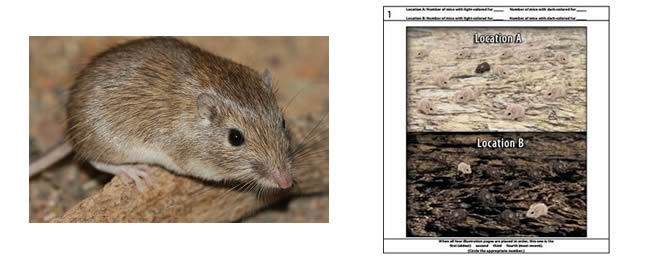

One gene, called Mc1r, stimulates production of the black pigment in coat fibers. Some of the genes exert more influence on the color palette than others, which fine-tune the hues and patterns. Scores of different genes control fur pigmentation, and thanks to modern genomic technology, they've all been identified at the DNA sequence level for lab mice. Biologists have worked out in fine detail the genetic and biochemical processes that control mammalian coat color, particularly for the common lab mouse, an evolutionary cousin of rock pocket mice. "But even after more than 50 years of intensive study," Nachman said, "we still don't know which genes are involved." In fact, he added, "there are very few examples where we actually know the genes that underlie an adaptation in nature, and almost no examples for cases of natural selection that are not induced by human disturbances," such as pesticide or heavy metal resistance. Peppered moths make a compelling case study in natural selection. A classic illustration of "survival of the fittest." As the cities reduced the pollution, the tree trunks lightened up, and so did the moths. Eventually, black became the norm for urban peppered moths. Better camouflaged than their light-colored brethren, the dark forms survived and proliferated. In a short time, though, dark variants of the moths sprang up. Coal soot from burgeoning industry gradually blackened tree trunks in urban areas, and left the moths more vulnerable to predators. In pre-industrial England, most peppered moths had mottled grey wings, camouflaging well with the birch trees upon which they rested. The story is reminiscent of the peppered moth lesson from high school biology class. Almost all of the mice collected from the volcanic formations had dark coats-the better to stay concealed from hungry owls, which can pick off mice from contrasting backgrounds even at night. Nachman's group collected pocket mice from two of these black rock islands-the Pinacate formation in southwestern Arizona and the Pedro Armendaris formation of New Mexico. But scattered throughout the southwest are islands of black basaltic rock formed from not-so-ancient lava flows. Most of the mice have light tawny fur, which blends in well with the desert granite substrates they typically inhabit. Nachman, examined the coat colors of rock pocket mice.

If the mice do not display appropriate behavior, we will give them the necessary experience to select the right types of foods and identify and escape predators in a safe environment.The group, led by Professor of ecology and evolutionary biology Michael W. Before we release offspring born at the facility to repopulate reserves in the wild, we will conduct similar behavioral assessments.

When we brought the first founder Pacific pocket mice into the facility, we measured these behaviors in order to generate a baseline for normal behavior. It is important that they have species-appropriate behaviors in order to successfully avoid predators and forage for the right types of food. We need to ensure that offspring born at the facility will be able to fend for themselves when, together with our partners, we eventually release them back into the wild. So far, we have more than doubled the number of mice at the facility with successful breeding of founder individuals and their offspring. Here, our Recovery Ecology and Conservation Genetics researchers are studying pocket mouse behavior, ecology, stress, and genetic variation to ensure that we successfully produce the most fit offspring for release and learn as much as we can about them along the way. Instead, we established the Pocket Mouse Conservation Breeding Facility at the San Diego Zoo Safari Park in 2012. Given the small number of Pacific pocket mice remaining in the wild, a translocation program to populate areas of former habitat was deemed to be too risky.

Unfortunately, due to habitat loss there are only three small populations remaining, one on Dana Point and two in military training areas on Marine Corps Base Camp Pendleton. For 20 years, they were actually thought to be extinct until a tiny remnant population was rediscovered in 1994 at Dana Point headlands. Pacific pocket mice used to be found from Los Angeles all the way to the Mexican border at the southern edge of San Diego County. Threats to Survival: Habitat loss and fragmentation Conservation Status: US Fish and Wildlife Service - Endangered


 0 kommentar(er)
0 kommentar(er)
